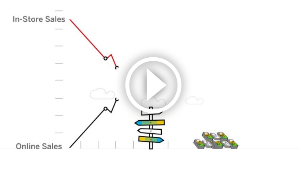How to Prepare for IT/OT Integration
Pierce Owen, VP of Research, SAPinsider
SAPinsider surveyed SAP customers on integrating SAP systems and information technology (IT) with operational technology (OT) on the factory and our research and conversations with leaders revealed many lessons when it comes to preparing for an integration project. Here, I share some of the key insights we learned through our research to help you prepare for IT/OT integration in your own organization.
Why IT/OT Integration?
While speaking with an SAP partner about another subject, the conversation turned when we started talking about the biggest obstacles to technology adoption. The gist of the conversation was that, essentially, IT professionals do not collaborate enough with people in operations. The operations teams have rich data but fail to maximize its value because they do not have the right IT tools. IT folks want to deploy the newest and best technology, but proofs of concept often fail to scale because IT turns it into a science project without the correct operational key performance indicators (KPIs) in place, which causes operations to shrug.
Explore related questions
The missed opportunities caused by this lack of collaboration make a strong case for integrating IT and OT. While the OT professionals often don’t see the benefit to them and their job, leveraging OT data on a factory floor in SAP or other IT systems can empower them to implement applications such as productivity control, predictive maintenance, and quality-as-built control. Even with only these basic applications, manufacturers can significantly improve uptime and productivity and cut down on quality issues.
Of course, it’s not as simple as just deciding to integrate IT and OT. There are challenges — and solutions.
What Are the Technical Problems and Solutions?
When you walk onto a factory floor, you’ll generally see machines, equipment, and robots from dozens of manufacturers, each of which has its own proprietary communication protocols that cannot exchange data with the equipment from other manufacturers, let alone any SAP system or other IT system. This prevents them from leveraging the best analytics tools on any data originating from those machines. Fortunately, solutions exist.
Based on our research, SAP customers typically approach the technical requirements of collecting, filtering, and integrating OT data with IT systems in one of three ways:
- Develop custom, in-house solutions to tie together different systems
- Utilize edge computing systems combined with OPC Unified Architecture (UA) servers
- Deploy Industrial Internet of Things (IIoT) integration solutions based on edge device middleware
The first option gives the SAP customer more control over customizing the solution to existing processes, but generally requires full-time dedicated employees to maintain the custom code, will not deploy quickly, and can cost more to maintain than the other solutions. Implementing OPC UA can help reduce the custom code somewhat, but does not eliminate it entirely, and without time-sensitive networking (TSN), the latency in data exchange often does not meet customer requirements. Only the third option has consistently proven to connect OT devices with native drivers without custom code, decrease installation and maintenance costs around existing equipment, and integrate with enterprise applications to increase uptime and productivity.
What to Expect from the Integration
So, what can businesses expect from integrating IT and OT? Survey respondents that we identified as leaders — that is, organizations that already use integrated IT and OT systems to generate business value — shared the following results:
- IT/OT integration projects met or exceeded leaders’ expectations. Of the leaders, 93% said that their integration met or exceeded their expectations. A majority (53%) also said that the integration led directly to easier access to data, one of the main goals of integration.
- The integration led to improved operational efficiency. In addition to easier access to data, 60% of leaders cited greater efficiency as a benefit of IT/OT integration, aligning with what they identified as their main drivers for this type of project.
- Integration leads to improved productivity. Due to productivity controls, visualizations, and lower-latency communications quickly identifying bottlenecks, a whopping 73% of leaders reported increased productivity as a result of IT/OT integration.
What Does This Mean for SAPinsiders?
Based on the outcomes reported by leaders in survey repsonses and our conversations with respondents, the following takeaways will help ensure a successful IT/OT integration project:
- Identify the business problems that access to the right OT data could solve. Industrial companies should not waste money and time trying to solve relatively complicated technical problems if they do not understand what they hope to accomplish from a business perspective beforehand. Increasing uptime of troublesome machines to increase the productivity of a line, reducing maintenance costs, and reducing quality issues all represent worthwhile problems to tackle.
- Educate leadership on available solutions to access and collect OT data. Even leaders in our survey struggle with custom code and slow OPC UA servers that prevent them from maximizing the value of their IT/OT integration projects. Circumvent these issues by working with leadership to explore IIoT integration software or edge middleware from companies such as Eurotech, Litmus Automation, Software AG, and Telit.
- Start tracking performance of manufacturing operations with performance analytics. If a company cannot easily analyze the success of its IIoT apps, it cannot make an educated decision on whether to scale. Set KPIs and ultimate goals for production lines and plants, and leverage advanced analytics to ensure that the KPIs lead to real results and to find the root causes of issues. Leaders do this because they can then better track the impact of other technologies and run experiments on what provides value and what does not.
- Leverage OT data in IT tools to generate business value with apps for productivity control, quality-as-built control, and predictive maintenance. Once a company can solve the technical problem of extracting data from previously siloed machines, it can then leverage that data in apps for productivity control to increase the productivity of individual machines, lines, or entire plants. It can monitor the quality of products as it builds them to catch issues as they happen. It can predict when machines or equipment will likely break and plan maintenance to minimize disruptions to production.
Following this strategic guidance should help SAP customers integrate IT and OT in a way that generates measurable business value. For additional insights and lessons learned, look for the upcoming SAPinsider benchmark report on “Integrating SAP with the Factory Floor: Road-mapping IT/OT Integration”.
Pierce Owen can be reached at Pierce.Owen@wispubs.com.








